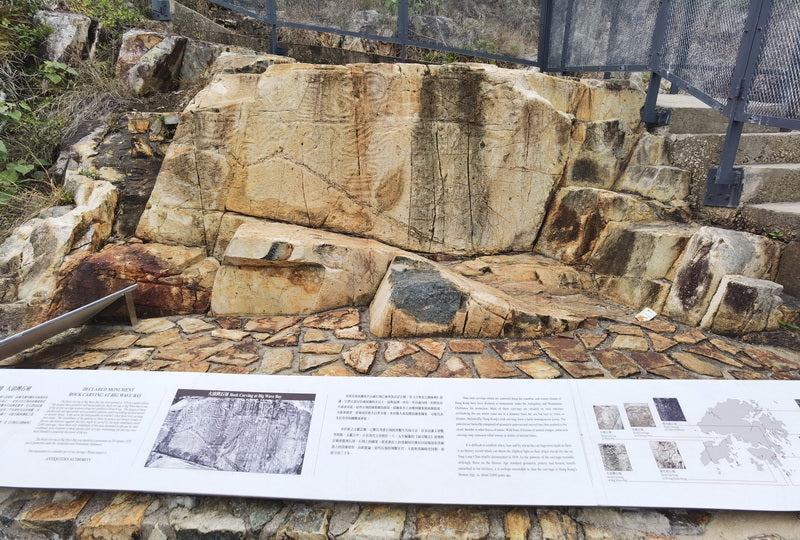
香港古代石刻 - 穿越三千年的山海密碼
Share
在香港這座現代都市的山海之間,隱藏著九處神秘而古老的石刻,它們靜靜訴說著三千年前青銅時代先民的故事。這些受《古物及古蹟條例》保護的珍貴遺產,不僅是歷史的見證,更是人與自然對話的永恆詩篇。讓我們以文字為舟,帶領您穿越時光,解讀這些刻在石頭上的遠古密語。
位於大浪灣的石刻,以幾何圖紋和抽象的鳥獸紋裝飾,與青銅時代的陶器和青銅器紋飾相似,彷彿是先民為鎮海護航而留下的祈願。需乘船才能抵達的滘西洲石刻,雖經風雨侵蝕,獸形紋樣仍依稀可見,訴說著時間的流逝與記憶的頑強。
全港最大的東龍洲石刻,猶如一條巨龍盤踞於石上,這處唯一被清代《新安縣志》記載的石刻,見證了歷史與傳奇的交匯。大嶼山石壁石刻因海岸變遷而遠離今日的海岸線,其方圓幾何紋飾與古代青銅器圖案相呼應,展現先民對幾何美學的追求。
蒲台島石刻的螺旋紋路如同時光漩渦,曲線與直線交織出抽象的遠古語言。長洲石刻的曲線環繞著小凹槽,形成獨特的視覺韻律。龍蝦灣石刻雖被歲月磨蝕,仍隱約可見鳥獸幾何圖形,引人無限遐想。
黃竹坑石刻獨特地位於溪流旁,三組幾何紋飾與其他石刻遙相呼應,特別是與長洲和蒲台島的石刻紋飾最為相似。黑角頭石刻高懸於峭壁之上,寬闊的幾何與曲線圖案,與大浪灣和東龍洲石刻風格相近,映照出早期沿海族群的繁榮景象。
這些石刻不僅是冰冷的岩石雕刻,更是先民與這片土地對話的生動見證。他們在浪花拍打的岩壁上刻下鎮海的願望,在溪流邊用幾何紋記錄對水源的敬畏,在孤島峭壁描繪對族群興旺的祈盼。

(圖片來源:古物古蹟辦事處)
Decoding 3,000 Years of Mountain and Sea Secrets | a Journey Through Hong Kong’s Ancient Rock Carvings
Amid the towering modern architecture of Hong Kong, hidden between the mountains and the sea, lie nine mysterious ancient rock carvings that silently tell the stories of people from the Bronze Age 3,000 years ago. These precious relics, protected under the Antiquities and Monuments Ordinance, are not only witnesses to history but also an eternal poetic dialogue between humans and nature. Let words be our vessel as we journey through time to decipher these ancient messages carved in stone.
The rock carving at Big Wave Bay, adorned with geometric patterns and abstract bird and animal motifs, resembles the designs found on Bronze Age pottery and bronzeware, as if left by ancient people as prayers for safe passage across the sea. The carving on Kau Sai Chau, accessible only by boat, though weathered by wind and rain, still faintly reveals beast-like patterns, speaking to the passage of time and the resilience of memory.
The largest rock carving in Hong Kong, located on Tung Lung Island, resembles a giant dragon coiled upon the stone. It is the only carving documented in the Qing Dynasty’s 《新安縣志》, serving as a testament where history and legend intersect. The rock carving at Shek Pik on Lantau Island, now distanced from the coastline due to changes in the shore, features square and circular geometric patterns that echo ancient bronzeware designs, showcasing the ancient people’s pursuit of geometric aesthetics.
The spiral patterns of the Po Toi Island carvings resemble whirlpools of time, with curves and straight lines intertwining to form an abstract ancient language. The Cheung Chau carving features curves encircling small depressions, creating a unique visual rhythm. Though worn by time, the Lung Ha Wan carving still faintly reveals bird and animal-like geometric shapes, sparking endless imagination.
Unique among them, the Wong Chuk Hang carving is situated beside a stream. Its three sets of geometric patterns resonate with other carvings, particularly those on Cheung Chau and Po Toi Island. The Blackhead Point carving, perched high on a cliff about 11 meters above sea level, features broad geometric and curved designs similar in style to those at Big Wave Bay and Tung Lung Island, reflecting the prosperity of early coastal communities.
These carvings are not merely cold stone engravings but vivid testaments to the dialogue between ancient people and this land. They carved prayers for calm seas onto wave-battered cliffs, recorded their reverence for water sources with geometric patterns along streams, and depicted their hopes for communal prosperity on remote island cliffs.
